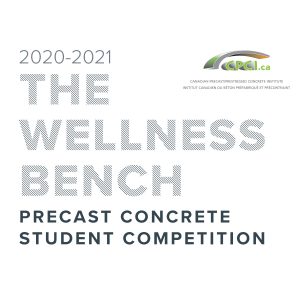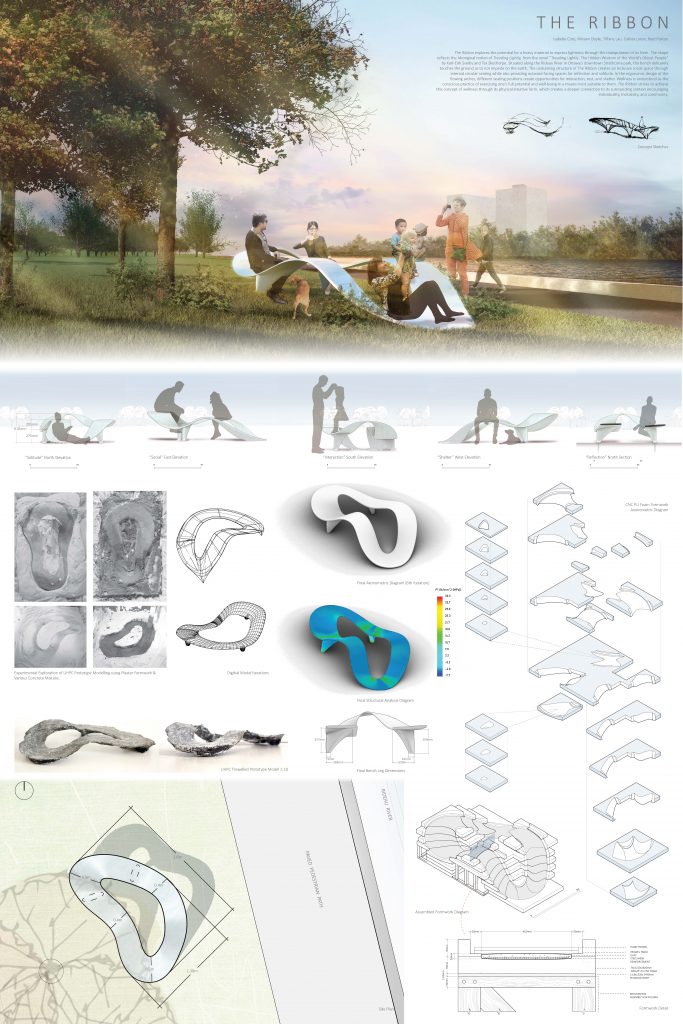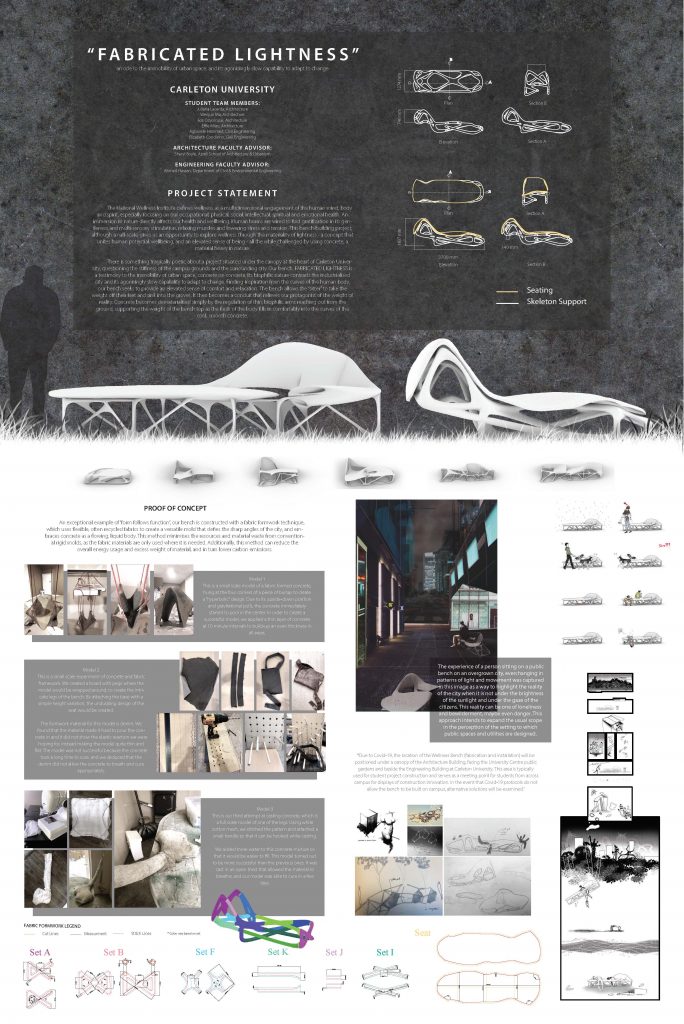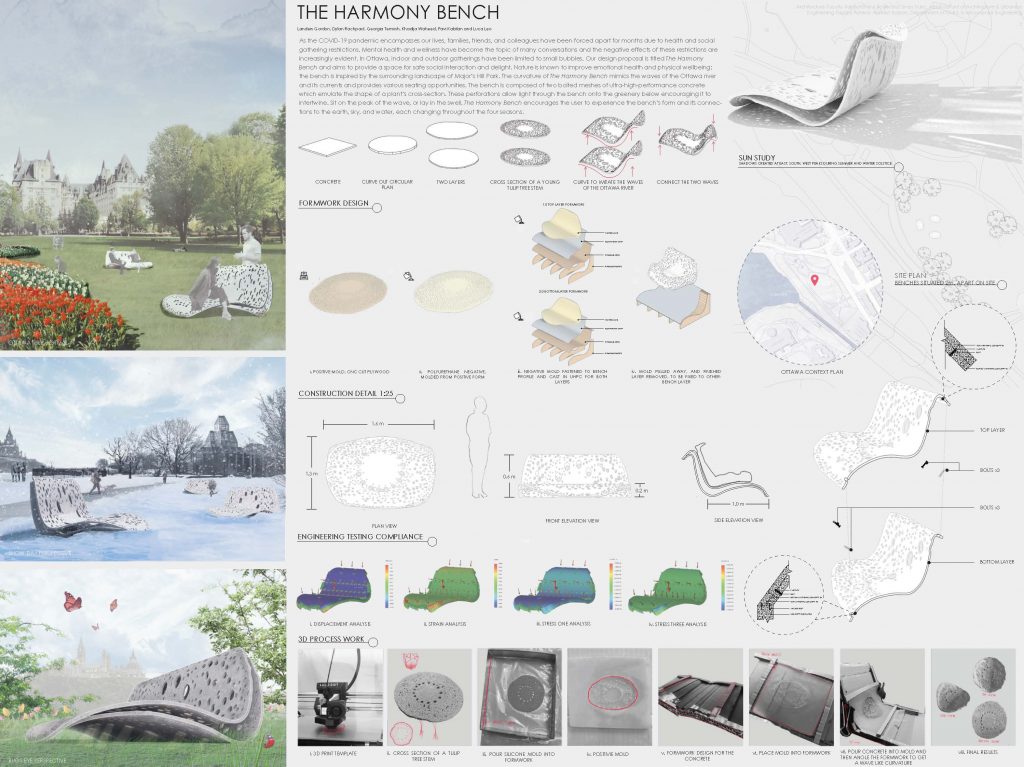Carleton Students Place in CPCI Wellness Bench Competition

Three teams of Carleton University architecture and engineering students have placed in a competition to design a bench that focuses on wellness.
The Canadian Precast/Prestressed Concrete Institute (CPCI) introduced the competition for architectural and engineering students in September 2020 as a pilot project. It was open to students from four Canadian universities.
The Ribbon Bench took second place with a prize of $1,350. The five team members were Isabelle Cote, Miriam Doyle, Tiffany Lau, and Calista Loten from the Azrieli School of Architecture & Urbanism, plus engineering student Reid Paxton.
“The bench demonstrates great flow,” said the jury. “It is aesthetically pleasing and is an innovative, multi-purpose design.”
The competition asked students to design a bench that focused on dimensions of wellness, defined as occupational, physical, social, intellectual, spiritual, and emotional. The submissions had to highlight opportunities offered by precast concrete in terms of construction, structural strength, design innovation, social value, maintenance, and durability.
Two Carleton University teams also received honourable mentions.
The Fabricated Lightness Bench team was composed of four architecture students: Juliana Lacerda de Oliveira, Wenjun Ma, Effie Miao, Ece Ozyolcular, and two engineering students: Elizabeth Condinho and Abgorele Hammed.
“The judges really liked your sophisticated and poetic design and your well-written report,” said the jury.
The Harmony Bench team had four architecture students: Georgia Temush, Khadija Waheed, Dylan Rachpaul, Landers Gordon, and two engineering students: Pavi Kabilan, and Luca Leo.
“Your bench was very creative and aesthetically pleasing,” said the jury. “The jury panel enjoyed the connection you made to nature and the City of Ottawa.”
The design submissions were part of Associate Professor Sheryl Boyle’s ARCS 4107 Studio: The Materiality of Lightness. She asked students to explore light and lightness in structures through material investigations, speculative drawing, innovation fabrication concepts, and digital collaboration.
Boyle acknowledged the “invaluable” assistance of research and teaching assistant Sinan Husic and engineering instructor Ahmed Hassan who served as advisor to the civil engineering students involved in the project.
Submissions were judged on graphic design, wellness goals, cultural and artistic value, community impact, environmental value, engineering, limit state design, and testing compliance.
“We were very impressed with the quality of the projects that were submitted,” said Ariane Sabourin, CPCI Marketing and Communications Manager. “We were blown away by the student’s hard work as well as their passion for working with precast concrete as a reliable and durable building material.”
The three winners of the competition received cash prizes and will have their work published in CPCI Imagineering Magazine, the CPCI Design and Building Express eNewsletter, and SABMag.
Ribbon Bench

The waves of the structure of The Ribbon create an inclusive social space through internal circular seating while also providing outward-facing spaces for reflection and solitude. In the design of the flowing arches, different seating positions create opportunities for interaction, rest, and shelter. The Ribbon strives to achieve the concept of wellness through its intuitive form, which creates a deeper connection to its surrounding context, encouraging individuality, inclusivity, and community.
Fabricated Lightness Bench

Finding inspiration from the curves of the human body, the Fabricated Lightness Bench seeks to provide an elevated sense of comfort and relaxation. The bench allows the “sitter” to take the weight off their feet and sink into the grooves. It then becomes a conduit that relieves our protagonist of the weight of reality. Concrete becomes dematerialized simply by the regulation of thin, biophilic arms reaching out from the ground, supporting the weight of the bench top as the flesh of the body fills in comfortably into the curves of the cool, smooth concrete.
“The judges really liked your sophisticated and poetic design and your well-written report,” said the jury.
Harmony Bench

The Harmony Bench aims to provide a space for safe social interaction and delight. Nature is known to improve emotional health and physical wellbeing; the bench is inspired by the surrounding landscape of Major’s Hill Park. The curvature of the bench mimics the waves of the Ottawa River and provides various seating opportunities. Sit on the peak of the wave, or lay in the swell. The Harmony Bench encourages the user to experience the bench’s form and its connections to the earth, sky, and water.
“Your bench was very creative and aesthetically pleasing,” said the jury. “The jury panel enjoyed the connection you made to nature and the City of Ottawa.”
The competition asked students to design a bench that focused on dimensions of wellness, defined as occupational, physical, social, intellectual, spiritual, and emotional. The submissions had to highlight opportunities offered by precast concrete in terms of construction, structural strength, design innovation, social value, maintenance, and durability.
The jury members were:
-Robert Thibodeau, architect and president, Thibodeau Architecture + Design;
-Karl Truderung, associate, PM/Precast/Structural, Tower Engineering;
-Steven Van Wyk, quality assurance manager/plant engineer, Stubbe’s Precast; and
-Ariane Sabourin, marketing and communications manager, CPCI.
See the winning projects here: